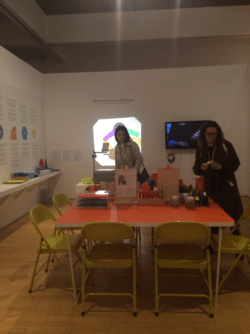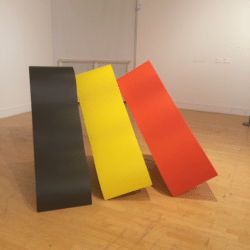A reminder of our younger selves: Kaleidoscope Exhibition review
The University of Warwick was founded in 1965 as part of the government’s aim to expand access to, and encourage citizens to seek, higher education. This ambition to broaden Britain’s access to education seems to be reflected in The Arts Council’s touring collection, the Kaleidoscope exhibition, which has recently opened at Warwick Art Centre’s Mead Gallery. Much of its artwork features colourful and fluid shapes, making it accessible to most.
But why, fifty years on from the opening of the university, is there a return to the primary? And how is this social rush from the 1960s to make education, and in particular art and culture, more accessible represented in this exciting exhibition?
And how is the social rush from the 1960s to make education, and in particular art and culture, more accessible represented in this exciting exhibition?
Kaleidoscope features work by many celebrated artists including Bridget Riley, Mary Martin, William Turnbull and Richard Smith. But what does the work by these talented arts have in common? They all share a strong sense of order, exuberance and bold simplicity. For the adult eye, which is perhaps more used to complex images and shapes, the exhibition is striking due to its daring lack of fine detail, and instead its focus on unusual forms and colour combinations.

Image Credits: Hannah Yager
But how would a group of children react in this space? The exhibition bears a strong resemblance to a primary school’s playground with its use of stimulating colours and shapes, which are often adopted to encourage and nourish early stages of learning development.
Ideas of the playground are reinforced by the exhibition’s ‘Creative Space’, allowing its spectators to experiment and create with colours and shapes
So, would a group of children be stimulated to run and play in this space? Should we also react in this way to the artwork, and abandon the strict conduct we usually assume in galleries? In order to fully appreciate the sensory awareness, which the striking artwork creates, perhaps the exhibition could have benefitted from music or a soundscape, such as the pitter-patter sounds created by rain sticks or a glockenspiel.

Image Credits: Hannah Yager
Ideas of the playground are reinforced by the exhibition’s ‘Creative Space’, allowing its spectators to experiment and create with colours and shapes. During adult life, we are not encouraged to take time out of our busy routines to sit, relax and be creative. This now seems like a peculiar gap in our lives, and moments at exhibitions such as these remind us of our own, often long forgotten, primary development.
During adult life, we are not encouraged to take time out of our busy routines to sit, relax and be creative
Much like the establishment of the University of Warwick, the Arts Council prides itself on “bringing people together and teaching us about ourselves”. The Kaleidoscope exhibition does both of these things, by calling upon our earlier stages in education to remind us of the simple yet enriching effects that art has on both children and adults alike. So go, explore and find that inner child-like curiosity for colour once more.

Comments